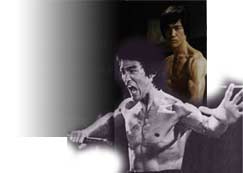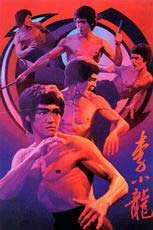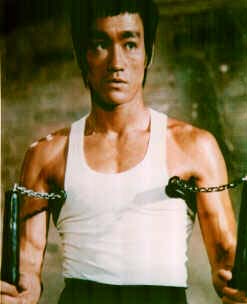An article by: Kim, SeungMo, www.taekwon.net
Bruce Lee: the name which will never fade from the history of martial arts or from the history of movies. He came and lit up the world with his gleaming eyes, nimble feet, and his trademark nunchaku. What is the reason for his enduring popularity even after he left this world.
1. Profile
Original Name Lee Jun Fan
Date of Birth November 27, 1940
Date of Death July 20, 1973
Place of Birth San Francisco
Family Linda Lee (wife), Brandon Lee (son), Shannon Lee (daughter)
Style Jeet Kune Do
Other Talents Dance: he won first place in a 1958 Cha Cha contest
Movie Debut 1964
Students Steve McQueen, James Coburn, Lee Marvin, Sterling Silliphant,
Kareem Abdul Jabaar
2. Life & Movie
Bruce Lee was born on November 27, 1940 in San Francisco. His father was
an actor performing in America at the time of Lee's birth. According to
one story, he was given the name Bruce by a nurse because they needed a
name for his American birth certificate. When he was still a baby his family
returned to Hong Kong. During his school years Bruce was quite the
prankster and never out of trouble. His parents were worried and moved
him to different schools but it was no better. So frequent were these moves
that his father's friends greeted him by saying, "Which school is your
boy at now?"

But Bruce practiced
martial arts diligently. He had already learned
Taichi chuan from his father and at13 began to learn Kung fu. His motivation
was simple. In high school he got in a fight with a scrawny classmate and
was whipped soundly. He later found out that this boy was learning Kung
fu. Bruce didn't like to lose and so began attending the Kung fu school
regularly.
In 1958 Bruce
Lee returned to America and studied Philosophy at the University of Washington
in Seattle. He was busy working as a waiter in a Chinese restaurant  but
managed to keep up his martial arts practice. And in 1964 he married Linda
Emory, also a student of martial arts. They were quite poor as students
and so moved to Oakland and opened a martial arts school. Then the chance
of a lifetime came to him. He was advertising his school by attending every
tournament he could. But in a 1964 tournament, he chose not to compete
and instead demonstrated Jeet Kune Do. The response was overwhelming. He
mesmorized the audience with his speed and precision and was hired by Twentieth
Century Fox as their martial arts teacher. Then he was chosen for the TV
series "The Green Hornet." This was his real beginning as an actor. He
received a lot of attention on "The Green Hornet." He was not the leading
man but he captivated viewers with his well-developed body and Asian martial
arts. Thanks to this program he became known in Hollywood and became friends
with Steve McQueen, Lee Marvin, and Kareem Abdul Jabaar. And to these famous
students he taught Jeet Kune Do.
but
managed to keep up his martial arts practice. And in 1964 he married Linda
Emory, also a student of martial arts. They were quite poor as students
and so moved to Oakland and opened a martial arts school. Then the chance
of a lifetime came to him. He was advertising his school by attending every
tournament he could. But in a 1964 tournament, he chose not to compete
and instead demonstrated Jeet Kune Do. The response was overwhelming. He
mesmorized the audience with his speed and precision and was hired by Twentieth
Century Fox as their martial arts teacher. Then he was chosen for the TV
series "The Green Hornet." This was his real beginning as an actor. He
received a lot of attention on "The Green Hornet." He was not the leading
man but he captivated viewers with his well-developed body and Asian martial
arts. Thanks to this program he became known in Hollywood and became friends
with Steve McQueen, Lee Marvin, and Kareem Abdul Jabaar. And to these famous
students he taught Jeet Kune Do.
In 1971, Bruce
Lee returned to make movies in Hong Kong. The reason was simple. In  Hollywood,
he and other Asians could not get leading roles. And he didn't care for
TV. Of course, he had tested his kicks and nunchaku on "The Green Hornet,"
but the moves of Jeet Kune Do were too large to be presented on a little
TV screen. If he were to show the true Jeet Kune Do, he thought he needed
the large movie screen. Bruce Lee's predictions came true. His first Hong
Kong movie, The Big Boss, was a huge success. His movies had a style all
their own. The way he pointed at his opponents with single finger, his
bent-kneed fighting stance, and the way he moved his feet ever so skillfully
and lightly, and his incredible amount of different kicks....And the scenes
where he took on 10 opponents, his flying side kick--all these were new
and so much more realistic and believable than previous martial arts movies.
Hollywood,
he and other Asians could not get leading roles. And he didn't care for
TV. Of course, he had tested his kicks and nunchaku on "The Green Hornet,"
but the moves of Jeet Kune Do were too large to be presented on a little
TV screen. If he were to show the true Jeet Kune Do, he thought he needed
the large movie screen. Bruce Lee's predictions came true. His first Hong
Kong movie, The Big Boss, was a huge success. His movies had a style all
their own. The way he pointed at his opponents with single finger, his
bent-kneed fighting stance, and the way he moved his feet ever so skillfully
and lightly, and his incredible amount of different kicks....And the scenes
where he took on 10 opponents, his flying side kick--all these were new
and so much more realistic and believable than previous martial arts movies.
Bruce gained world-wide fame from The Big Boss
and then began to build his legend. The movie following The Big Boss was
Fists of Fury and can be called his masterpiece. Here we saw him wipe his
nose as he faught with nunchaku, and we also first saw him scowl and scream
after delivering
the final blow to an opponent. Fists of Fury was also a huge hit and elevated
his status as an actor. The next year he guaranteed his position with Way
of the Dragon. It was the first Hong Kong movie filmed on location in Italy
and it introduced Chuck Norris as a new action star. In 1973 Warner Brothers
contacted him to film Enter the Dragon. It was a hit all over the world.
It sent him into the ranks of world stardom. Screaming he took on tens
of opponents alone and seeing such charisma no one could stop talking about
it. But, the first Asian superstar, Bruce Lee, died mysteriousy during
the filming of his next movie, Game of Death. Regrettably he was only 32
years old.
delivering
the final blow to an opponent. Fists of Fury was also a huge hit and elevated
his status as an actor. The next year he guaranteed his position with Way
of the Dragon. It was the first Hong Kong movie filmed on location in Italy
and it introduced Chuck Norris as a new action star. In 1973 Warner Brothers
contacted him to film Enter the Dragon. It was a hit all over the world.
It sent him into the ranks of world stardom. Screaming he took on tens
of opponents alone and seeing such charisma no one could stop talking about
it. But, the first Asian superstar, Bruce Lee, died mysteriousy during
the filming of his next movie, Game of Death. Regrettably he was only 32
years old.
Bruce Lee left us with one unfinished and five complete movies. After his death he was flattered by a ton of pretenders, and Jackie Chan and Jet Lee later continued his grand tradition but they lacked his charisma. In some ways, Bruce Lee is the first and last true martial arts moviestar. On his grave is written: "Bruce Lee, Founder of Jeet Kune Do." He rests not as an imitator of Peking Opera but as the founder of a new martial art.
 one
into which he put together various practical techniques from all kinds
of martial arts in the world, on the base of Chinese kwonbups(military
arts) he had learned from his childhood. In 1967, in an interview with
the international martial art magazine called `Black Belt', he explained
Jeet Kune Do as follows: "At 13, I could find out some limitations of Youngchoon
Kung fu, that I've learned from master Yupmoon, and I have made an martial
art of a new style, and it is Jeet Kune Do into which only strong points
are integrated from all kinds of martial arts I've learned by now. Ironically,
it was not in the Dojang(gym) but on the sickbed that he completed Jeet
Kune Do, the martial art for actual fighting, in a systematic way. While
he had his back injured and was ill in bed for 6 months in 1970, he started
to write a book, planning to finish it by 1971. His wife Linda wrote to
his dictation, and, everything about martial arts that he had been using
was recorded through picures and description in it. The materials were
all notes that he had written at odd moments, about experiences both from
more than 2000 books that he'd read and from actual fighting. The title
of the book is nothing else but "Jeet Kune Do". It was an overture to the
mythtic of Bruce Lee.
one
into which he put together various practical techniques from all kinds
of martial arts in the world, on the base of Chinese kwonbups(military
arts) he had learned from his childhood. In 1967, in an interview with
the international martial art magazine called `Black Belt', he explained
Jeet Kune Do as follows: "At 13, I could find out some limitations of Youngchoon
Kung fu, that I've learned from master Yupmoon, and I have made an martial
art of a new style, and it is Jeet Kune Do into which only strong points
are integrated from all kinds of martial arts I've learned by now. Ironically,
it was not in the Dojang(gym) but on the sickbed that he completed Jeet
Kune Do, the martial art for actual fighting, in a systematic way. While
he had his back injured and was ill in bed for 6 months in 1970, he started
to write a book, planning to finish it by 1971. His wife Linda wrote to
his dictation, and, everything about martial arts that he had been using
was recorded through picures and description in it. The materials were
all notes that he had written at odd moments, about experiences both from
more than 2000 books that he'd read and from actual fighting. The title
of the book is nothing else but "Jeet Kune Do". It was an overture to the
mythtic of Bruce Lee.
 a
sort of Naega kwonbup, from his father, Lee, Hae-chun. Taegeukkwon is known
to have been established at the close of the 17th century, having developed
among Chin family, who had lived together around Chinga-gu, Haanam-sung,
China. It is a martial art that mainly stresses on Kigong. Growing up,
he kept going further, practicing 'Tangnangkwon', 'Konglyukkwon', and 'Youngchoonkwon'.
'Tangnangkwon'(which was devised after a praying mantis catching a locust,
and whose main technique is 'younhwan danta', looking similar to one-two-straight
in boxing), 'Taegeukkwon' and 'Konglykkwon' are popular kwonbups belonging
to the North School, and 'Youngchoonkwon' is the representative kwonbup
of the South School. What divides kwonbups into two schools is the characteristics
that have developed in a distinct way under the geological environment
of Yangtsu river, one of the main rivers in China, dividing the country
into the north and the south. For the North School, the postures are broad,
and bopups(steps or walking) are rather light, and on the other hand, for
the South School, the postures are narrow and jumping is seldom required.
Besides, 'Tangnangkwon', 'Konglyukkwon', and 'Youngchoonkwon' are Waega
kwonbups, fundamentally focused on muscle power and physical skill, but
Taegeukkwon is a traditional Naega kwonbup, stressing on Naegong and Kigong.
By these things, he was able to absorb arts from both schools as well as
from both Naega and Waega(internal and external) kwonbups.
a
sort of Naega kwonbup, from his father, Lee, Hae-chun. Taegeukkwon is known
to have been established at the close of the 17th century, having developed
among Chin family, who had lived together around Chinga-gu, Haanam-sung,
China. It is a martial art that mainly stresses on Kigong. Growing up,
he kept going further, practicing 'Tangnangkwon', 'Konglyukkwon', and 'Youngchoonkwon'.
'Tangnangkwon'(which was devised after a praying mantis catching a locust,
and whose main technique is 'younhwan danta', looking similar to one-two-straight
in boxing), 'Taegeukkwon' and 'Konglykkwon' are popular kwonbups belonging
to the North School, and 'Youngchoonkwon' is the representative kwonbup
of the South School. What divides kwonbups into two schools is the characteristics
that have developed in a distinct way under the geological environment
of Yangtsu river, one of the main rivers in China, dividing the country
into the north and the south. For the North School, the postures are broad,
and bopups(steps or walking) are rather light, and on the other hand, for
the South School, the postures are narrow and jumping is seldom required.
Besides, 'Tangnangkwon', 'Konglyukkwon', and 'Youngchoonkwon' are Waega
kwonbups, fundamentally focused on muscle power and physical skill, but
Taegeukkwon is a traditional Naega kwonbup, stressing on Naegong and Kigong.
By these things, he was able to absorb arts from both schools as well as
from both Naega and Waega(internal and external) kwonbups.
 Actually Bruce said, "Kung fu is for fighters, not for monks. Some meditation
or breaking some pieces of bricks have nothing to do with Kung fu. Kung
fu for defense only is just like swimming out of the water," Likewise,
Jeet Kune Do is such an aggressive and exceptional martial art. Since it
is mainly for actual fights, Jeet Kune Do has no fixed forms. Normally
martial arts put much importance on the stance, but Jeet Kune Do has no
formalized stance. Only does it have powerful and fast hand and foot techniques,
needed for real fighting. It doesn't matter whether you stretch out your
right hand or you shout loudly or anything. The most important is to take
the most comfortable stance. Therefore, Jeet Kune Do teaches you to take
what is necessary and, also to throw away what is not. That is, all that
you need in Jeet Kune Do is mix up your strengths with necessary techniques.
Actually Bruce said, "Kung fu is for fighters, not for monks. Some meditation
or breaking some pieces of bricks have nothing to do with Kung fu. Kung
fu for defense only is just like swimming out of the water," Likewise,
Jeet Kune Do is such an aggressive and exceptional martial art. Since it
is mainly for actual fights, Jeet Kune Do has no fixed forms. Normally
martial arts put much importance on the stance, but Jeet Kune Do has no
formalized stance. Only does it have powerful and fast hand and foot techniques,
needed for real fighting. It doesn't matter whether you stretch out your
right hand or you shout loudly or anything. The most important is to take
the most comfortable stance. Therefore, Jeet Kune Do teaches you to take
what is necessary and, also to throw away what is not. That is, all that
you need in Jeet Kune Do is mix up your strengths with necessary techniques.